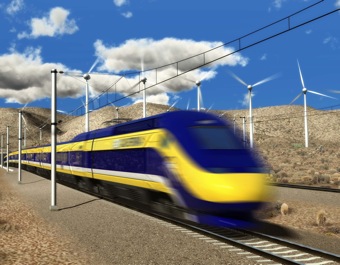A Berkeley study says it just might — but not right away
By Roger Rudick
Near Antwerp, Belgium, there’s a two-mile section of high-speed rail (HSR) line with solar panels over the tracks to help power the system. That kind of technology is essential to maximizing environmental benefits from California’s proposed bullet train, according to a new study co-authored by Berkeley’s School of Civil and Environmental Engineering. California is poised to begin construction of an HSR line from San Francisco to Los Angeles early next year.

But before the electrically powered trains start cleaning up California’s air, they have to make it dirtier. That’s because the construction generates pollution. “We calculated after ground breaking, so the net benefits come at best 10 years after the system starts running,” said Mikhail Chester, a professor at Arizona State and a study author.
And some of that depends on how quickly people switch from driving and flying to using the train, he added. According to the study, entitled “High-speed rail with emerging automobiles and aircraft can reduce environmental impacts in California’s future,” 67% of the construction pollution for HSR comes from making cement. “But construction is a one-time cost…the benefits continue for the life of the system,” he said.
“We have long supported HSR as an alternative to oil-powered automobiles and jet planes,” said Darrell Clarke, co-lead of the Sierra Club’s national “Beyond Oil” campaign. “The alternative is not doing nothing. The state is growing. Instead of building HSR we could widen highway 99, expand airports—so you’re going to use all those bulldozers and pour all that concrete anyway.”
The study compared HSR trains in Germany with the estimated carbon emissions of future automobiles, assuming a mix of 35-to-55 mpg hybrid and all-electric cars become the norm in California. Under all scenarios, HSR showed benefits in the long run.
[module align=”left” width=”half” type=”pull-quote”]It’s important to find the sweet spot that does the most to reduce emissions over all.[/module]
“I think the point about running smaller trains during off-peak times is important, to avoid excess capacity,” said Rick Geddes, Associate Professor, Department of Policy Analysis and Management at Cornell, in reference to the study. He also pointed out a difficult trade-off: the faster the trains, the more power they consume. But higher speeds attract riders from heavily polluting airplanes—so it’s important to find the sweet spot that does the most to reduce emissions over all,
he said.
That’s why HSR builders are working on faster, more energy-efficient designs. The latest version of the TGV, France’s high-speed train, goes 220 mph—about 30 mph faster than the previous generation. But it’s lighter and consumes less power, said Adam Pratt, a spokesman for Alstom, which builds the train.
Even if California HSR is powered by wind and solar, bad regulations could negate the benefits, according to the study. Under a cap-and-trade policy in which the right to emit carbon is sold on the open market, the efficiencies of the train could drive down the price of carbon offsets. In other words, if the “cap” is too high, the train could just end up making it cheaper for other sectors to pollute.
But assuming the state can avoid self-defeating policies, the only other way to reduce carbon emissions is to impede travel, said Clark. “Because under any scenario, California’s going to continue to grow.”
Lawmakers authorized $4.5 billion in state funds, to be matched by $3.2 billion in federal funds. The initial segment would run from Fresno to Bakersfield, with concurrent work to improve commuter rail services in Northern and Southern California. The trunk of the project will eventually stretch from Anaheim to San Francisco and cost $68 billion.
Roger Rudick has closely covered the evolution of California’s High Speed Rail project. His documentary work on is profiled at www.trainwars.net.
One thought on “Can a Bullet Train Shrink California’s Carbon Footprint?”
Comments are closed.

With California only contributing 1% to the world’s greenhouse
gases, the 37 million citizens of our State that will be paying more for their
energy, food, and transportation fuels will need a good story from our legislatures
as AB32 will impact many that can least afford more costs to live and work in California.
These extra costs to businesses and citizens will most
likely fuel the continuing exodus of businesses from California, help drive up further
unemployment and increase the deficit, while we have no impact on the world’s
greenhouse gases.
If everyone rode the bullet train and there were no cars, we
would have no impact on the world’s greenhouse gases.
With California only contributing 1% to the world’s greenhouse
gases, the 37 million citizens of our State that will be paying more for their
energy, food, and transportation fuels will need a good story from our legislatures
as AB32 will impact many that can least afford more costs to live and work in California.
These extra costs to businesses and citizens will most
likely fuel the continuing exodus of businesses from California, help drive up further
unemployment and increase the deficit, while we have no impact on the world’s
greenhouse gases.
If everyone rode the bullet train and there were no cars, we
would have no impact on the world’s greenhouse gases.